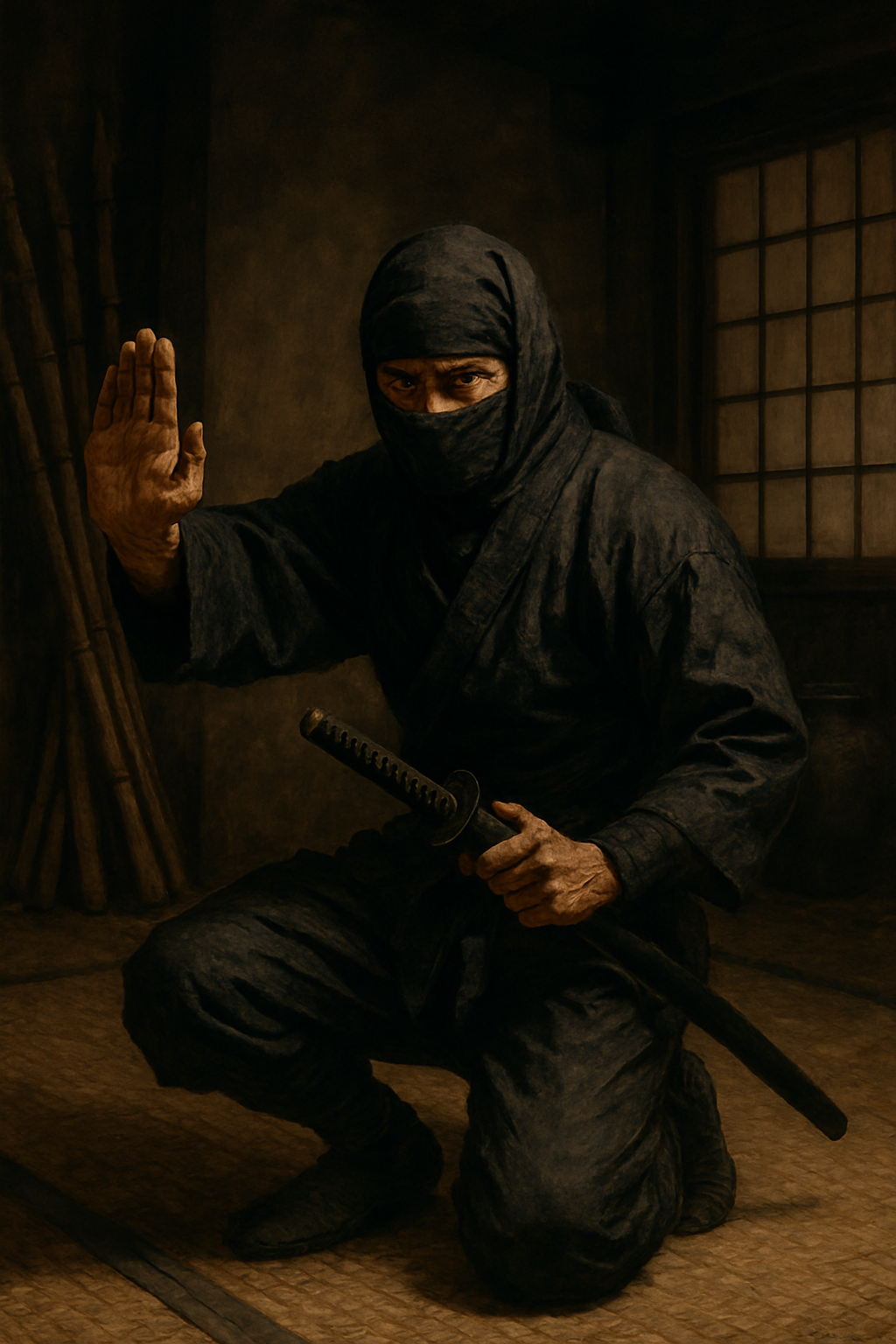本物の忍者の秘密の修行 – 伝説を超えた技術
「忍者」と聞くと、皆の者はどのような姿を思い浮かべるか?
黒装束に身を包み、手裏剣を投げ、屋根から屋根へと飛び回る――映画や漫画で描かれる忍者の姿は実に魅力的じゃ。しかし、実際の忍者はそのような派手な戦闘よりも、もっと奥深い修行を積み、己の身を守り、情報を集め、そして生き延びる技術を磨いておったのじゃ。
今回は、本物の忍者がどのような修行を積んでいたのか、その秘密を紐解いていこうぞ!
忍者の修行は「生きる力」を鍛えるものだった
忍者の修行は、単に戦う技術を身につけるものではなかった。
むしろ、いかに敵と戦わずに情報を得るか、いかに危険を避けて生き延びるか、それが最も重要とされておったのじゃ。
そのため、忍者の修行は次のような能力を鍛えることに重点を置いておった。
1. 体術 – 身を守る技
忍者は剣術や格闘技だけでなく、素早く身をかわし、敵の攻撃を無力化する「体術」を修行しておった。特に重要なのが受け身の技術じゃ。高所から落ちても怪我をせず、地面を転がって衝撃を逃がす技は、まさに命を守る術であった。
また、「猫のように静かに歩く忍び足」も重要な技術の一つじゃ。音を立てずに移動することは、敵に気づかれずに任務を遂行するために欠かせなかったのじゃ。
2. 変装術 – どこにでも溶け込む技
忍者は決して「忍者の姿」のまま活動することはなかった。むしろ、旅の僧侶、商人、農民、時には芸人に扮し、敵地に潜入することが多かったのじゃ。
そのため、ただ衣装を変えるだけでなく、言葉遣いや立ち居振る舞いも変える必要があった。例えば、商人に扮するなら計算ができなければならず、旅芸人ならば簡単な芸を身につける必要があった。つまり、忍者は「どこにでも溶け込めるカメレオン」のような存在だったのじゃ。
3. 知識と記憶術 – 情報こそが武器
忍者は戦いの達人であるよりも、実は「情報の達人」だった。
敵の陣地に忍び込み、警備の人数や重要人物の動きを記憶し、それを持ち帰るのが忍者の重要な任務の一つじゃった。
しかし、紙に書いて持ち帰れば、もし捕まった時に証拠となってしまう。
そこで忍者は、情報を頭の中にすべて記憶する「記憶術」を鍛えておった。独自の記憶法を用い、一度見た地図や文章を正確に覚える訓練をしていたのじゃ。
4. 自然との調和 – 風、音、匂いを読む技
忍者は自然の中で生きる術も身につけておった。
風の向きを読んで敵の接近を察知し、水の流れを見て隠れられる場所を見つける。
また、匂いにも敏感じゃった。煙の匂いや人の匂いをかぎ分け、敵が近くにいるかどうかを判断したり、食べ物が毒入りでないかを嗅ぎ分ける訓練もしていたのじゃ。まさに、現代のサバイバル技術の先駆けとも言える能力を持っていたのじゃな。
5. 心の修行 – 忍耐と集中力
忍者は肉体だけでなく、精神も鍛え抜かれていた。
どれだけ過酷な状況でも冷静さを失わず、恐怖をコントロールし、必要な時に動けるようにするためじゃ。
例えば、暗闇の中で何時間もじっと待つ訓練や、激しい空腹や寒さに耐える修行を行っていた。これは、まさに「動く禅」とも言える精神鍛錬で、現代のメンタルトレーニングにも通じるものがあるのじゃ。
まとめ – 忍者は戦うだけではない!
映画やゲームでは派手なアクションで描かれる忍者じゃが、実際の忍者は「戦わずに生き抜く術」を極めた者たちじゃった。
そのために鍛えられた技術は、現代にも通じる知恵が詰まっておる。
もし本物の忍者の技を学びたければ、まずは「生きる力」を鍛えることじゃ!
忍者の教えを現代に活かし、日々の生活に取り入れてみるのも一興じゃな。
さあ、現代に生きる忍者たちよ、自らの「忍びの道」を歩むがよいぞ!
【以下英語版】【English version below】
The Secret Training of Real Ninja: Skills Beyond the Myths
When you hear the word “ninja,” what kind of image comes to mind?
A figure dressed in black, throwing shuriken, and leaping from rooftop to rooftop—this is the portrayal of ninjas in movies and manga. While this image is fascinating, real ninjas trained in far more profound techniques, focusing not just on combat but on survival, intelligence gathering, and deception.
Today, let’s unravel the secret training of real ninjas and explore their extraordinary skills!
Ninja Training: A Discipline for Survival
Ninja training was not simply about mastering combat techniques.
More importantly, it was about acquiring the skills to gather intelligence, avoid conflict, and survive in dangerous situations.
Thus, ninja training focused on developing the following abilities:
1. Taijutsu – The Art of Protecting Oneself
Ninjas were skilled not only in sword fighting and hand-to-hand combat but also in “taijutsu,” the art of movement and evasion. One of the most crucial skills was ukemi (breakfall techniques)—a method that allowed them to land safely even when falling from high places. By rolling and dispersing the impact, they could avoid injury and quickly get back on their feet.
Another essential skill was silent movement (shinobi-ashi)—walking like a cat, making no sound while moving. This was vital for sneaking into enemy territory undetected.
2. Disguise – Blending into Any Environment
Contrary to popular belief, ninjas rarely operated in their so-called “ninja uniforms.” Instead, they disguised themselves as monks, merchants, farmers, or even entertainers to infiltrate enemy territories.
However, disguising themselves wasn’t just about changing clothes; they had to alter their speech, posture, and behavior to avoid suspicion. For example, a ninja posing as a merchant needed to understand trade and calculations, while one disguised as an entertainer had to know how to perform simple tricks or dances. In essence, ninjas were like human chameleons, able to blend seamlessly into any setting.
3. Knowledge and Memory Techniques – Information as a Weapon
Ninjas were not just warriors; they were masters of intelligence gathering.
Their missions often involved sneaking into enemy territories, memorizing the number of guards, key figures’ movements, and strategic locations, then returning to report the information.
However, writing down information was risky—if captured, it could serve as evidence.
Thus, ninjas trained in advanced memory techniques to store maps, names, and even coded messages in their minds. Their memory training allowed them to recall detailed information with exceptional accuracy.
4. Harmony with Nature – Reading Wind, Sound, and Smell
Ninjas also mastered the art of sensing their environment.
They could detect the presence of enemies by observing changes in the wind or listening to subtle sounds.
Additionally, they had an acute sense of smell. They could distinguish different odors to identify nearby enemies or detect poisoned food. This ability to read nature gave them a survival advantage in both espionage and escape situations.
5. Mental Training – Patience and Concentration
A ninja’s strength lay not only in their physical abilities but also in their mental resilience.
They underwent rigorous training to maintain composure under extreme conditions, control fear, and react only when necessary.
For example, they practiced staying completely still in darkness for hours, enduring hunger and cold, and training their minds to remain calm even in life-threatening situations. This discipline can be seen as a form of “moving Zen,” similar to modern meditation techniques that enhance focus and emotional control.
Conclusion – Ninjas Were More Than Fighters!
Although modern media often portrays ninjas as action heroes, real ninjas were masters of survival, intelligence, and adaptability.
Their skills went beyond mere combat; they focused on outwitting opponents, blending into society, and acquiring knowledge to stay one step ahead.
If you wish to learn from real ninja techniques, start by honing your survival skills, sharpening your mind, and observing the world with heightened awareness.
The wisdom of the ninja is timeless, and by applying their principles, you too can walk the path of the modern-day shinobi!
Now, fellow warriors of the present, embrace your own “ninja way” and master the art of survival!
This translation should capture the essence of the original article while making it engaging for an English-speaking audience. Let me know if you need any refinements!



